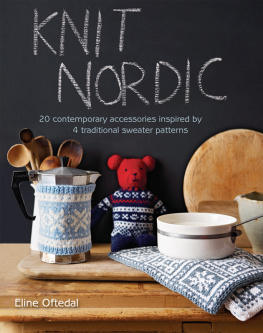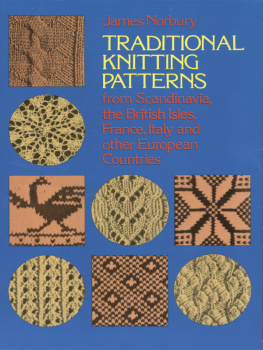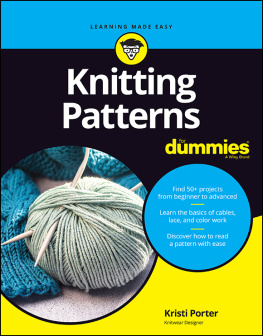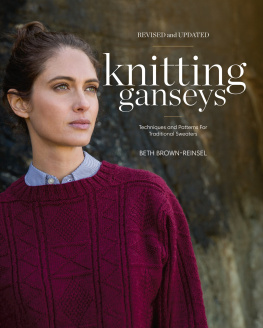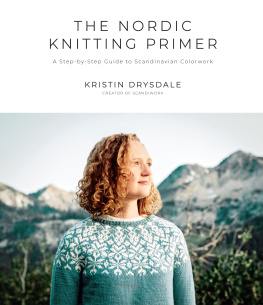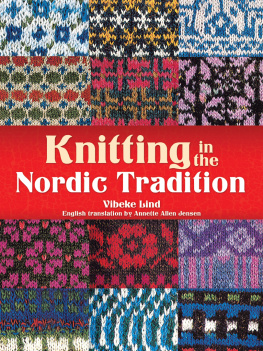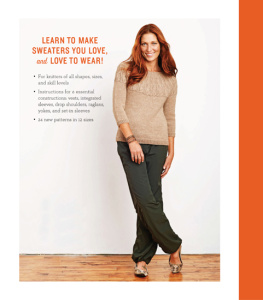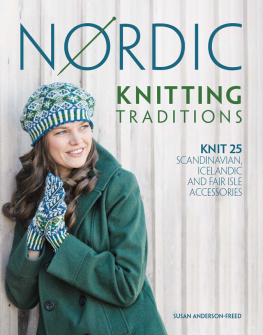

CONTENTS

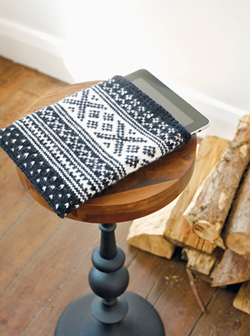

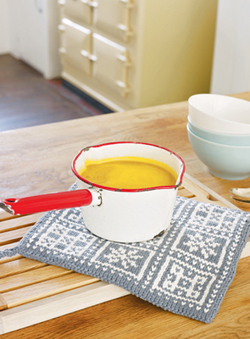
INTRODUCTION

If you are reading this book, you probably already like to knit, or are thinking that you would like to try it out. Its easy to see why you might want to make your own accessories and clothes knitted garments and accessories are always in fashion! No catwalk or home interiors magazine is without knitted items, summer or winter. If you look closely at modern fashions you will often recognize traditional styles: fishermens cable sweaters, geometrically patterned Norwegian styles and intricate, colourful Fair Isle patterns are perennial fashion favourites among designers.
The great thing about knitting is that you can easily make stylish designs yourself once you have mastered a few basic skills. It is a very portable hobby: you can knit wherever you are and it is easy to tuck your work in progress into a bag when you go out. For me, knitting has been a pleasant way to pass time in airports and spend evenings away from home. I have worked for many years in international politics and knitting has made all the travelling more bearable, although its not as good as knitting snugly at home!
In times past, knitting was often an activity that brought a bit of extra income to a family. My grandmother used to handknit Marius sweaters for a Norwegian company, and my mother told me that she was sent out to pick up the yarn to bring home for her mother. My grandmother was not paid much, but it was a contribution to the familys income. In a continuation of knitting tradition, it was my mother who taught me to knit and my grandmother who taught me to crochet.
In this book you will find 20 projects inspired by four traditional Norwegian patterns: the Setesdal sweater, the Fana cardigan, the Marius ski sweater and the Voss cardigan. My inspiration for this book came from thinking that these classic garments were large and time-consuming projects to embark upon; sometimes you end up with a garment so warm that, with a bit of luck on the cold-weather front, you might only wear once a year.
This book offers you fresh ways to enjoy these design classics by reimagining them in new forms and shapes; you can keep your gadgets protected with the .
The book not only offers knitting inspiration with its fresh twists on Norwegian designs, but there are also basic patterns here that you could easily adapt to other colourways. If you like a project but dont like the colours, just imagine it all in white and you have a clean slate to colour it the way you want to.
If, like me, you appreciate traditional Norwegian knitting and prefer modern, stylish accessories and household items, I am sure you will like the patterns in this book. I hope the book will inspire you to think of new forms and shapes to knit and to update traditional designs by applying them in fresh and original ways.

A taste of my Norway: blue tit chicks feeding at my summer house; a winter scene by Randsfjorden lake; lambs grazing in Lofoten.
KNITTING IN NORWAY
People have been knitting in Norway for centuries. Socks and undergarments, which need to have more flexibility than woven fabrics, were probably the first knitted items that were produced. Sweaters have probably been knitted since the early to mid-1700s. This book was inspired by four of the classic Norwegian patterns, but the history and heritage of our knitting tradition is much richer: if you want to learn more, I recommend the book Everyday Knitting: Treasures from a Ragpie by Annemor Sundb.
Norways distinctive sweater patterns have become known all over the world as a result of trade. The Norwegian word for sweater is genser, which derives from the word gansey, the name of the traditional Guernsey fishermens sweaters. Some of the patterns in this book have a long history, some have a shorter one, but they all have a fascinating heritage.

In the 1950s and 60s, knitted sweaters were at their most popular. Any school photo from that time shows all the pupils in handknitted sweaters.

The handsome downhill skier, actor and World War II hero Marius Eriksen helped to make the Marius sweater a must-have among young people in Norway. His sweater was knitted by his mother, Bitten Eriksen.
Marius
Marius is the youngest of the patterns featured in this book; it first appeared in the 1950s, but traces its roots back to the Setesdal pattern. The birth of the Marius pattern is like a drama from the knitting world, with some handsome downhill skiers and an Olympic gold medal thrown in for good measure.
Handknit sweaters were the height of fashion in the postwar era, and many designers shared their creativity in knitting magazines and booklets published by yarn producers. Bitten Eriksen was a knitwear designer who created designs for a wool mill. She was also the mother of the well-known skiers Stein and Marius Eriksen; Stein won a gold medal at the Oslo Winter Olympics in 1952. The Marius pattern is a variety of the Setesdal pattern rendered in the Norwegian flag colours of red, white and blue, and Bittens published designs, modelled by her famous sons, became very popular and sold well. Another knitwear designer, Unn Syland Dale, happened to work for the Eriksens sports store in Oslo; she sold a pattern very similar to the Marius design to a rival wool mill, thus triggering a dispute over property rights for what remains the most popular knitting pattern in Norway to this day. As the sweater was so heavily inspired by Setesdal, the pattern is regarded as common property, and officially neither woman is the mother of the Marius sweater. However, they both contributed to giving subsequent generations a classic sweater to love.
Traditional knitting patterns have always changed and developed throughout the years. It was in the 1930s that patterns became standardized through magazines and books from yarn producers. As knitters, we have always copied each other but often add a personal twist. I hope you will add your own personal twist to the patterns you knit from this book and hence become a little part of our knitting history.

Next page
